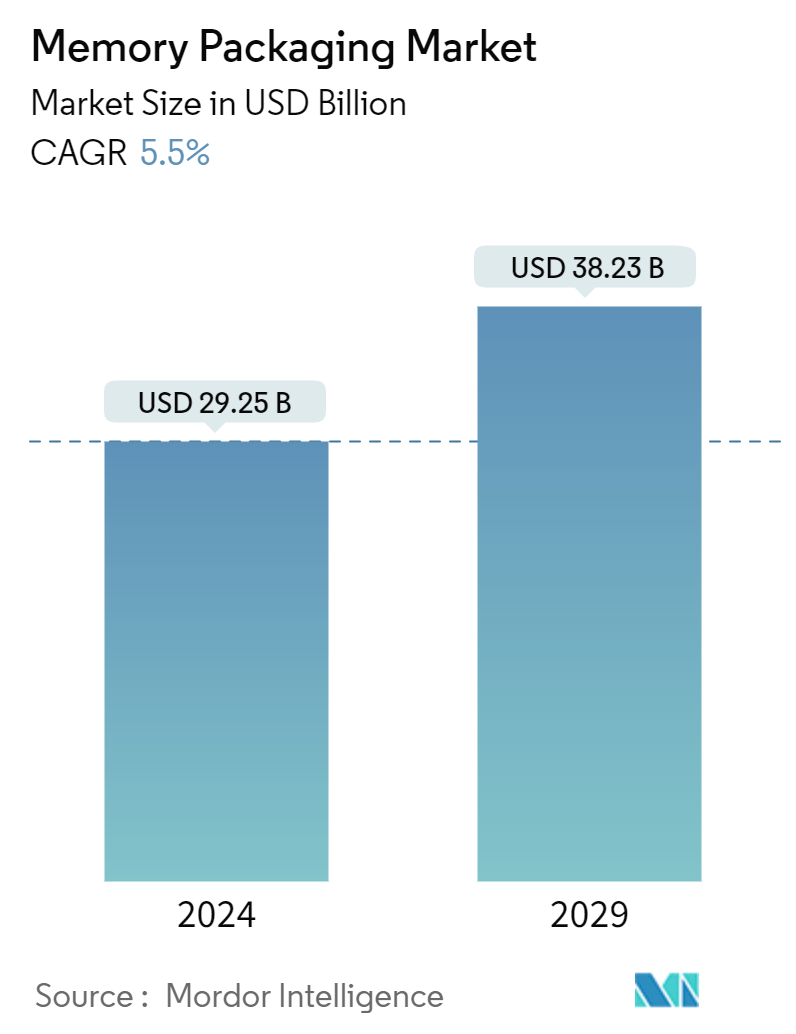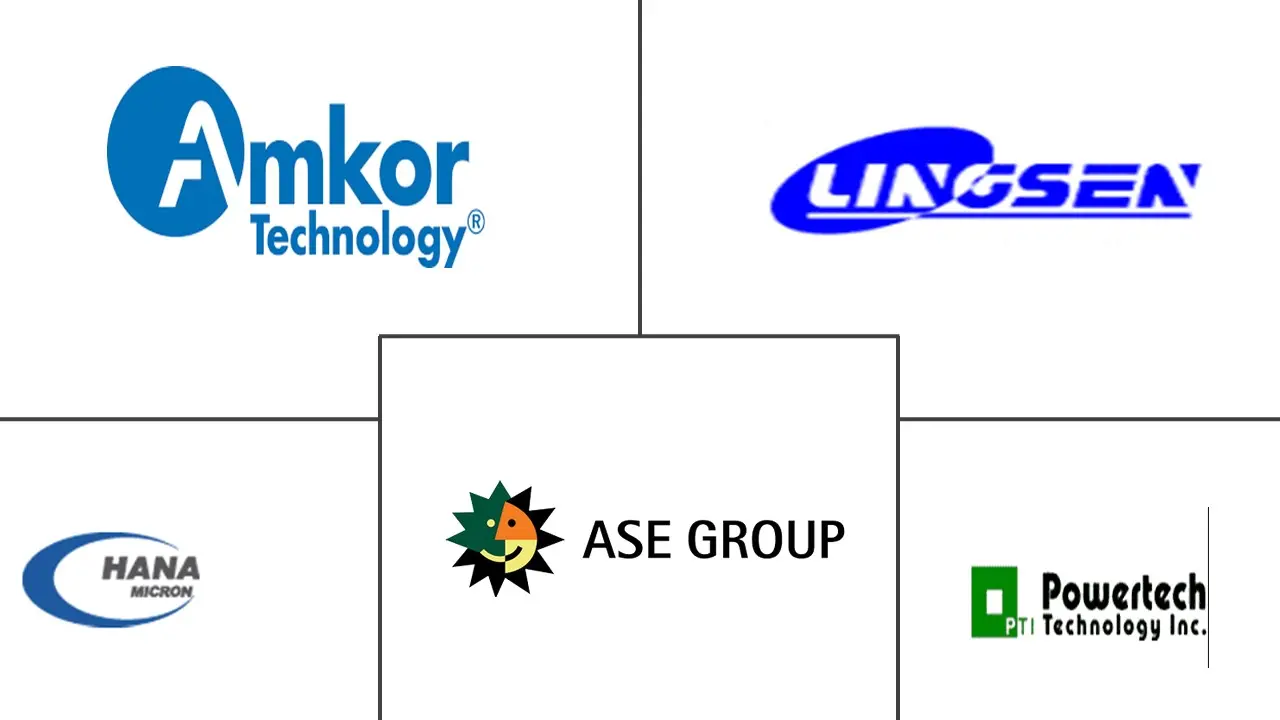Market Size of Memory Packaging Industry

| Study Period | 2019 - 2029 |
| Market Size (2024) | USD 29.25 Billion |
| Market Size (2029) | USD 38.23 Billion |
| CAGR (2024 - 2029) | 5.50 % |
| Fastest Growing Market | Asia Pacific |
| Largest Market | Asia Pacific |
Major Players
*Disclaimer: Major Players sorted in no particular order |
Memory Packaging Market Analysis
The Memory Packaging Market size is estimated at USD 29.25 billion in 2024, and is expected to reach USD 38.23 billion by 2029, growing at a CAGR of 5.5% during the forecast period (2024-2029).
The recent COVID-19 outbreak is expected to create significant imbalances in the supply chain of the market studied, as Asia-Pacific, particularly China, is one of the major influencers of the market studied. Also, many of the local governments in the Asia-Pacific have invested in the semiconductor industry in a long run program, hence, expected to regain market growth. For instance, the Chinese government raised around USD 23 to 30 billion funds, to pay for the second phase of its National IC Investment Fund 2030. Owing to the uncertainty in the recovery time of the market from the pandemic, economic impacts on several parts of the world are further expected to provide significant challenges to the growth of the semiconductor market, directly affecting the availability of critical raw materials required for advanced memory packaging market globally.
- Memory devices employed a broad range of the packaging technology that include flip-chip, lead-frame, wire-bond, through-silicon via (TSV). With the decrease in dimensions and increase in the chip functionality, a higher number of the electrical connections have to be made to the external circuit.
- This has also led to development in packaging technologies. Flip-chip, TSV, and wafer-level chip-scale Packaging (WLCSP) are promising technologies to satisfy wider bandwidth, faster speed, and smaller/thinner package. Comprehensible program adjustments, low engineering costs, and easy changeovers are fueling the demand for the wire-bond memory packaging platform.
- Additionally, due to changes in the package design, the wire-bond memory packaging platform continues to be used as the most preferred interconnection platform because of its flexibility, reliability, and low-cost. Flip-chip began making inroads in the DRAM memory packaging in 2016 and was expected to grow due to its increased adoption in the DRAM PC/server, fueled by high bandwidth requirements.
- Spurred on by high bandwidth and memory chips' low latency demands for high-performance computing in numerous applications, through-silicon via (TSV), is being employed in high bandwidth memory devices.
Memory Packaging Industry Segmentation
Memory modules consist of tiny semiconductor chips that must be packaged in a way in which they can be easily integrated into rest of the system. Memory integrated circuits are mounted as per requirements to make the modules function properly. The scope of the report includes classification on the basis of platform, application across different memory types, end-user industry, and geography. The study also provides a brief analysis of the impact of COVID-19 on the market and its growth.
| By Platform | |
| Flip-chip | |
| Lead-frame | |
| Wafer-level Chip-scale Packaging(WLCSP) | |
| Through-silicon Via (TSV) | |
| Wire-bond |
| By Application | |
| NAND Flash Packaging | |
| NOR Flash Packaging | |
| DRAM Packaging | |
| Other Applications |
| By End-user Industry | |
| IT and Telecom | |
| Consumer Electronics | |
| Automotive | |
| Other End-user Industries |
| Geography | |
| North America | |
| Europe | |
| Asia-Pacific | |
| Rest of the World |
Memory Packaging Market Size Summary
The memory packaging market is poised for significant growth, driven by advancements in packaging technologies and increasing demand from mobile and computing sectors. The market is experiencing a shift towards more sophisticated packaging solutions like flip-chip, through-silicon via (TSV), and wafer-level chip-scale packaging (WLCSP) to meet the demands for higher bandwidth, faster speeds, and more compact designs. These technologies are particularly beneficial for high-performance computing applications, including AI and HPC, where low latency and high bandwidth are critical. The automotive sector is also expected to contribute to market growth, with the rising trend of autonomous driving and in-vehicle infotainment systems driving the demand for DRAM memory. Additionally, strategic alliances and expansions by key players in the industry are expected to enhance market reach and competitiveness.
The market landscape is moderately competitive, with major players like Samsung Electronics Co. Ltd. and SK Hynix Inc. leading the charge in innovation and capacity expansion. The increasing integration of sensor technology in portable devices is further propelling the demand for memory packaging solutions. Despite the challenges posed by the COVID-19 pandemic and supply chain disruptions, the market is expected to recover and grow, supported by government investments in the semiconductor industry, particularly in the Asia-Pacific region. The ongoing developments in packaging technology, coupled with the rising demand for 3D NAND, are likely to intensify competition among vendors, driving further advancements and market dynamics over the forecast period.
Memory Packaging Market Size - Table of Contents
-
1. MARKET DYNAMICS
-
1.1 Market Overview
-
1.2 Industry Attractiveness - Porter's Five Forces Analysis
-
1.2.1 Bargaining Power of Suppliers
-
1.2.2 Bargaining Power of Consumers
-
1.2.3 Threat of New Entrants
-
1.2.4 Threat of Substitutes
-
1.2.5 Intensity of Competitive Rivalry
-
-
1.3 Industry Value Chain AnalysiS
-
1.4 Technology RoadmaP
-
1.5 Assessment of Impact of COVID-19 on the Market
-
1.6 Market Drivers
-
1.6.1 Emerging Trend of Autonomous Driving and In-vehicle Infotainment
-
1.6.2 Increase in Demand for Smartphones
-
1.6.3 Memory Semiconductor Business Explosion
-
1.6.4 Continuous Developments in High-bandwidth Memory (HBM) and Redistribution Layer
-
-
1.7 Market Challenges
-
1.7.1 Harsh Reliability Requirements in the Automotive Environment
-
1.7.2 Changing Landscape of the OSATs Industry
-
-
-
2. MARKET SEGMENTATION
-
2.1 By Platform
-
2.1.1 Flip-chip
-
2.1.2 Lead-frame
-
2.1.3 Wafer-level Chip-scale Packaging(WLCSP)
-
2.1.4 Through-silicon Via (TSV)
-
2.1.5 Wire-bond
-
-
2.2 By Application
-
2.2.1 NAND Flash Packaging
-
2.2.2 NOR Flash Packaging
-
2.2.3 DRAM Packaging
-
2.2.4 Other Applications
-
-
2.3 By End-user Industry
-
2.3.1 IT and Telecom
-
2.3.2 Consumer Electronics
-
2.3.3 Automotive
-
2.3.4 Other End-user Industries
-
-
2.4 Geography
-
2.4.1 North America
-
2.4.2 Europe
-
2.4.3 Asia-Pacific
-
2.4.4 Rest of the World
-
-
Memory Packaging Market Size FAQs
How big is the Memory Packaging Market?
The Memory Packaging Market size is expected to reach USD 29.25 billion in 2024 and grow at a CAGR of 5.5% to reach USD 38.23 billion by 2029.
What is the current Memory Packaging Market size?
In 2024, the Memory Packaging Market size is expected to reach USD 29.25 billion.

